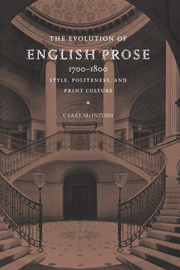Book contents
- Frontmatter
- Contents
- Preface
- 1 The ordering of English
- 2 Literacy and politeness: the gentrification of English prose
- 3 Testing the model
- 4 Loose and periodic sentences
- 5 Lofty language and low
- 6 Nominal and oral styles: Johnson and Richardson
- 7 The New Rhetoric of 1748 to 1793
- 8 The instruments of literacy
- 9 Politeness; feminization
- 10 Style and rhetoric
- Epilogue: language change
- References
- Index
3 - Testing the model
Published online by Cambridge University Press: 18 December 2009
- Frontmatter
- Contents
- Preface
- 1 The ordering of English
- 2 Literacy and politeness: the gentrification of English prose
- 3 Testing the model
- 4 Loose and periodic sentences
- 5 Lofty language and low
- 6 Nominal and oral styles: Johnson and Richardson
- 7 The New Rhetoric of 1748 to 1793
- 8 The instruments of literacy
- 9 Politeness; feminization
- 10 Style and rhetoric
- Epilogue: language change
- References
- Index
Summary
The more we know about how intelligence is communicated from one head to another, the less inclined we are to dismiss any part of it as secondary.
(Dwight Bolinger, Intonation and its Parts: 1986)How representative are the teaspoonfuls of prose analysed in chapter 2, 8,000 words drawn from the great rivers of English published between 1700 and 1725, or between 1775 and 1800? Those who write grammars for schools are probably more sensitive to the orderliness of their prose than most people, and more conscious of correctness and formality. If gentrification was a linguistic as well as a stylistic phenomenon, if it affected most of the prose of the time, it would show up in proletarian as well as in academic texts, in novels and in stage plays, in philosophers and poets. Changes that look like gentrification may be detected by relatively cursory examination of major authors from the two ends of the century: Sheridan's dialogue is cleaner and more elegant than Steele's; Jane Austen's sentences are more periodic and her paragraphs more coherent than Defoe's; Godwin's critical essays are fussier and more prolix and more precise than John Dennis's. But what about the most careful and sophisticated writers of the first two decades of the eighteenth century, such as the third Earl of Shaftesbury or Alexander Pope? What about less-educated writers of the last two decades of the century?
The texts I have chosen to test the “gentrification and literacy” model are intended to be both representative and diverse; they speak for their age, but with more than one voice.
- Type
- Chapter
- Information
- The Evolution of English Prose, 1700–1800Style, Politeness, and Print Culture, pp. 42 - 75Publisher: Cambridge University PressPrint publication year: 1998



